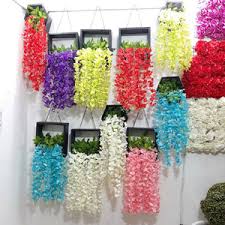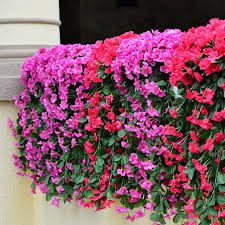Hanging flowers are a delightful way to bring the beauty of nature into your surroundings. Whether you have a spacious garden, a cozy balcony, or even just a small window, these dangling blooms can instantly transform any space into a charming oasis. Their versatility and ease of care make them an excellent choice for both seasoned gardeners and those new to the world of plants.
One of the most significant advantages of hanging flowers is their ability to make use of vertical space. By suspending them from baskets, pots, or even decorative containers, you can create a cascading effect that draws the eyes upward and makes the area feel more expansive. This makes them a perfect solution for those with limited floor space or those who wish to add an extra layer of interest to their surroundings.
When it comes to choosing the right hanging flowers, the options are virtually limitless. Petunias, with their vibrant and eye-catching blooms, are a popular choice for many gardeners. Their low maintenance requirements and excellent adaptability to different climates make them an ideal option for beginners.
Another fabulous choice is the fuchsia plant, with its unique and elegant flowers that dangle gracefully from the stems. These charming blooms come in various colors, from soft pastels to bold and bright hues, making them a perfect fit for any color scheme.
For those looking to create a lush and green atmosphere, trailing foliage plants like the English ivy or the heartleaf philodendron are excellent selections. These green wonders not only add a touch of elegance but also provide a sense of tranquility and relaxation to any space.
Caring for hanging flowers is surprisingly simple, even for those without a green thumb. Adequate watering, ensuring the soil is moist but not waterlogged, is crucial for most hanging plants. Regular deadheading – removing spent flowers – will encourage continuous blooming and keep the plant looking tidy. Applying a balanced liquid fertilizer every two to four weeks during the growing season will provide the necessary nutrients for healthy growth.
When it comes to choosing the right location for your hanging flowers, keep in mind their sunlight requirements. While some plants thrive in bright and direct sunlight, others prefer partial shade or indirect light. Placing the hanging baskets or pots in the right spot will ensure the plants flourish and bloom to their full potential.
Aside from their visual appeal, hanging flowers offer a few practical benefits too. For instance, some varieties like the mosquito plant (Citronella) and marigolds are known for their ability to naturally repel insects. So, by hanging these flowers in strategic spots, you can enjoy your outdoor space without the annoyance of buzzing bugs.
However, hanging flowers are a simple and beautiful way to infuse any space with the wonders of nature. Their versatility, ease of care, and the wide array of options available make them an attractive choice for gardening enthusiasts and novices alike. By carefully selecting the right hanging flowers and providing them with proper care, you can create a captivating and refreshing environment that will be the envy of all who visit your space. So, why not bring the allure of hanging flowers into your life and experience the joy they bring firsthand.
Read Also: Significance and Uses of Love Flowers
Importance of Hanging Flowers

Hanging flowers hold significant importance in various aspects of our lives, contributing to the enhancement of beauty, health, and overall well-being. These charming floral displays offer more than just visual appeal; they bring numerous benefits that positively impact both indoor and outdoor environments. Let’s explore the importance of hanging flowers:
1. Aesthetics and Ambiance: One of the most obvious reasons for the significance of hanging flowers is their ability to enhance the aesthetics of any space. Whether in gardens, balconies, patios, or indoors, these delightful blooms add a touch of natural beauty and charm. Their vibrant colors, unique shapes, and delicate fragrance create a pleasant and inviting atmosphere, uplifting moods and improving the overall ambiance.
2. Stress Reduction and Relaxation: Scientific studies have shown that exposure to nature and natural elements, such as hanging flowers, can have a calming effect on the human mind. The presence of greenery and blooming flowers has been linked to reduced stress levels, anxiety, and even lower blood pressure. Having hanging flowers around can help create a tranquil and peaceful environment, promoting relaxation and a sense of well-being.
3. Air Purification: Plants, including hanging flowers, play a crucial role in improving air quality by absorbing carbon dioxide and releasing oxygen through the process of photosynthesis. Additionally, some flowers, such as Peace lilies and Gerbera daisies, have been found to remove harmful toxins like formaldehyde and benzene from the air. By hanging these flowers indoors, you can improve indoor air quality and promote better respiratory health.
4. Biodiversity and Pollinators: Hanging flowers attract a variety of pollinators such as bees, butterflies, and hummingbirds. These pollinators play a vital role in the ecosystem by facilitating plant reproduction. By providing a welcoming space for these creatures, hanging flowers contribute to biodiversity and help sustain the balance of nature.
5. Space Optimization: The ability of hanging flowers to utilize vertical space is a practical advantage, especially for those with limited gardening areas. Whether in small apartments or urban settings, hanging flowers offer a way to bring nature into spaces where traditional gardens might not be feasible. They allow people to enjoy the benefits of gardening without requiring large plots of land.
6. Connection to Nature: In today’s fast-paced and technologically-driven world, maintaining a connection to nature is essential for human well-being. Hanging flowers offer a simple yet effective way to bring a touch of the natural world into our lives. Caring for these plants and witnessing their growth and blossoms can foster a sense of responsibility and appreciation for the environment.
7. Social and Community Impact: Hanging flower displays have the power to create a sense of community and social interaction. Shared gardens and public spaces adorned with hanging flowers can become gathering spots, where people come together, appreciate nature’s beauty, and foster a sense of unity among neighbors.
In addition, hanging flowers are more than just pretty decorations; they hold immense importance for our overall well-being and the environment. From enhancing aesthetics and promoting relaxation to purifying the air and fostering biodiversity, these blooms enrich our lives in numerous ways. By incorporating hanging flowers into our surroundings, we can experience the many benefits they offer and cultivate a deeper connection with nature.
Planting and Hanging Techniques

Planting and hanging hanging flowers require some specific techniques to ensure their health and attractiveness. Whether you are working with traditional hanging baskets, pots, or more creative containers, following these steps will help you create stunning displays of cascading blooms:
1. Choose the Right Container: Select a suitable container with drainage holes to prevent waterlogging and root rot. Hanging baskets with coconut coir or moss lining are excellent choices as they provide good drainage while retaining moisture.
2. Soil Preparation: Use a high-quality potting mix that is well-draining and rich in nutrients. Avoid using garden soil, as it may compact in containers and hinder root growth.
3. Plant Selection: Pick hanging flowers that match the sunlight conditions of your chosen location. Consider the mature size of the plants, ensuring they won’t overcrowd the container as they grow.
4. Preparing the Container: Fill the hanging container with potting mix, leaving enough space to accommodate the root ball of the plant.
5. Planting: Gently remove the hanging flower from its nursery pot, being careful not to damage the roots. Create a hole in the center of the container and place the plant’s root ball into it. Fill the gap around the root ball with more potting mix and lightly press down to secure the plant.
6. Watering: After planting, thoroughly water the hanging flowers. Ensure the water reaches all parts of the root system. Water the flowers regularly, but avoid overwatering, as this may lead to root rot.
7. Pruning and Deadheading: Regularly prune back leggy growth and remove dead or faded flowers (deadheading) to encourage continuous blooming and maintain a neat appearance.
8. Fertilizing: Feed your hanging flowers with a balanced liquid fertilizer every two to four weeks during the growing season. Follow the manufacturer’s instructions for application rates.
9. Choosing Hanging Locations: Place your hanging flowers in locations that match their sunlight requirements. Many hanging flowers prefer full sun, but some may thrive in partial shade or indirect light.
10. Hanging Options: Use sturdy hooks or brackets to hang your containers securely. Consider the weight of the container when selecting hanging hardware.
11. Proper Height: Hang your containers at an appropriate height for easy maintenance and to create eye-catching displays. Consider the mature size of the plants to avoid overcrowding and entanglement.
12. Wind Protection: If your hanging flowers are exposed to strong winds, consider providing some wind protection to prevent damage to delicate blooms and foliage.
13. Regular Maintenance: Inspect your hanging flowers regularly for signs of pests, diseases, or nutrient deficiencies. Take prompt action if any issues arise to prevent further damage.
14. Seasonal Adjustments: As seasons change, adjust your care routine accordingly. Be prepared to protect your hanging flowers from frost or extreme heat.
By following these planting and hanging techniques, you’ll create a flourishing and picturesque display of hanging flowers that will brighten up your living spaces and bring joy throughout the year. Remember to water and care for your hanging flowers regularly, and they will reward you with a beautiful cascade of colors and sweet fragrances.
Choosing the Right Hanging Flowers

Selecting the right hanging flowers is essential to create captivating and thriving displays that complement your space and match your gardening expertise. Consider the following factors when choosing hanging flowers:
1. Sunlight Requirements: Determine the amount of sunlight your hanging location receives. Some flowers thrive in full sun, while others prefer partial shade or even full shade. Choose hanging flowers that match the sunlight conditions of your chosen spot.
2. Climate Suitability: Consider the climate of your region. Some hanging flowers are more tolerant of heat, humidity, or cold temperatures, while others may require specific conditions to flourish. Opt for flowers that are well-suited to your local climate for better success.
3. Space and Size: Take into account the available space for your hanging flowers. If you have limited space, choose compact varieties or trailing plants that won’t overwhelm the area as they grow. Ensure that the mature size of the plants fits well within the hanging container.
4. Flowering Season: Decide if you want hanging flowers that bloom all year round or those that have distinct flowering periods. Some plants offer continuous blooms, while others may have specific seasons of vibrant blossoms.
5. Watering and Maintenance: Assess your gardening commitment and choose hanging flowers that match your level of maintenance. Some plants require regular watering and grooming, while others are more low-maintenance.
6. Colors and Aesthetics: Consider the overall aesthetics you want to achieve with your hanging flowers. Choose a color palette that complements your existing outdoor or indoor decor. Create eye-catching displays by combining contrasting or complementary colors.
7. Hanging Basket Types: Different hanging flower varieties suit different types of containers. Some flowers do well in traditional hanging baskets with coconut coir or moss lining, while others may thrive in pots, wall planters, or hanging bags. Match the flower type to the container for optimal growth.
8. Fragrance: If you enjoy the scent of flowers, select hanging varieties that emit delightful fragrances. Flowers like lavender, petunias, and sweet alyssum are known for their pleasant aromas.
9. Pollinator Attractiveness: To support local pollinators like bees, butterflies, and hummingbirds, choose hanging flowers that are known to attract these beneficial creatures. Pollinators are essential for plant reproduction and biodiversity.
10. Personal Preferences: Ultimately, consider your personal preferences and taste. Choose hanging flowers that bring you joy and align with your vision for your garden or living space.
Popular hanging flowers that are well-suited for various conditions include petunias, fuchsias, geraniums, begonias, impatiens, lobelia, verbena, and trailing varieties of ivy and pothos for indoor spaces.
Before making your final choices, research the specific care requirements of the hanging flowers you’re interested in to ensure they align with your gardening abilities and time commitment. With thoughtful consideration and the right selection, your hanging flowers will flourish and add a touch of natural beauty to your surroundings.
Read Also: Anthurium Flowering Plants (Flamingo Flower): Complete Growing and Care Guide
Essential Care Tips of Hanging Flowers

Proper care is essential to keep your hanging flowers thriving and looking their best. By following these essential care tips, you can create stunning displays that bring joy and natural beauty to your living spaces:
1. Watering: Regular and consistent watering is crucial for hanging flowers. Check the moisture level of the soil daily and water when the top inch of the soil feels dry to the touch. Avoid overwatering, as it can lead to root rot. On the other hand, make sure not to let the soil dry out completely, as some hanging flowers are sensitive to drought.
2. Sunlight: Pay attention to the sunlight requirements of your hanging flowers. Ensure they receive the appropriate amount of sunlight based on their specific needs. If they require full sun, place them in a location that gets at least 6 to 8 hours of direct sunlight each day. For plants that prefer partial shade, provide them with dappled sunlight or filtered light.
3. Fertilizing: Feed your hanging flowers with a balanced liquid fertilizer every two to four weeks during the growing season. Follow the manufacturer’s instructions for dilution and application rates. Fertilizers rich in phosphorus (the middle number on the fertilizer label) can encourage more blooms.
4. Deadheading: Regularly remove spent flowers (deadheading) to encourage continuous blooming. Deadheading redirects the plant’s energy towards producing new blooms rather than setting seeds.
5. Pruning: Trim back leggy growth and remove any dead or diseased parts of the plant. Pruning promotes a bushier and more attractive growth habit.
6. Wind Protection: If your hanging flowers are exposed to strong winds, provide some wind protection. Strong winds can damage delicate blooms and foliage, so consider moving the hanging container to a sheltered spot during windy periods.
7. Pest and Disease Management: Inspect your hanging flowers regularly for signs of pests or diseases. Early detection allows you to address these issues promptly and prevent them from spreading. Use organic pest control methods whenever possible to avoid harmful chemicals.
8. Temperature Sensitivity: Some hanging flowers may be sensitive to extreme temperatures. Protect them from frost during colder months and provide shade during heatwaves to prevent damage.
9. Seasonal Adjustments: Be prepared to adjust your care routine according to the changing seasons. During colder months, you may need to reduce watering frequency, while in hot summers, you may need to water more often.
10. Support and Training: Some hanging flowers, like vining plants, may require support and training. Use small trellises or stakes to guide their growth and prevent them from becoming tangled or overwhelming other plants.
11. Regular Inspection: Observe your hanging flowers regularly for any signs of stress, nutrient deficiencies, or other issues. Promptly address any problems to maintain the health and beauty of your plants.
By following these essential care tips, you’ll ensure that your hanging flowers thrive, providing you with a continuous display of natural beauty and delighting you and others who admire your hanging garden. Remember that each plant species may have specific care requirements, so it’s essential to research the needs of the particular hanging flowers you have chosen. With proper care and attention, your hanging flowers will flourish and bring joy throughout the seasons.
Read Also: Best Starbucks Drinks For You
